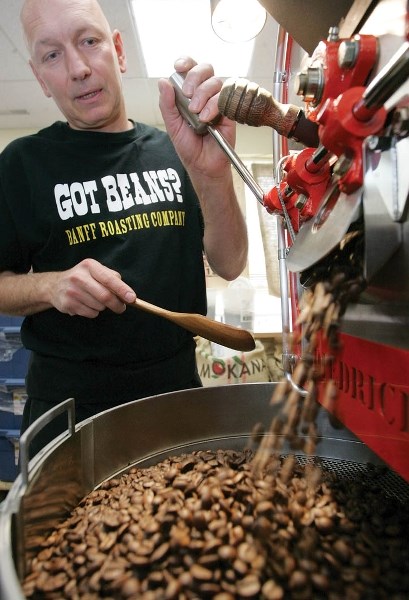Dave Whitfield BANFF
There’s just nothing like the smell of fresh ground, fresh brewed coffee in the morning.
Ask almost anybody.
Coffee is generally regarded as the second most traded commodity in the world, after crude oil and, while Banff is rarely linked to power players in the oil industry, a couple of entrepreneurs are hoping to make their mark in coffee.
A few short months ago, Banffites Norm O’Genski and Marten Brenner decided to get into the coffee roasting business with their Banff Roasting Company.
Specializing in small batches, the company has already expanded its reach in the local marketplace and now offers product in Banff food operations like Nesters Market, Cake Company Cafe, Ticino Swiss-Italian Restaurant, Grizzly House, Bare Bistro, gifts shops such as Goro Canyon Smoke and Gift, Pika Village Gifts and Banff Original Gifts and in Canmore at Nutter’s Bulk and Natural Foods.
Currently, Banff Roasting Company beans are available in six aptly-named roasts: Sundance Canyon (medium), Sleeping Buffalo (medium/dark), Peyto’s Brew (medium/dark), Bear 64 (dark), Mt. Rundle Roast (espresso) and Howling Wolf (medium/dark organic).
Located in a tiny office on Eagle Crescent in the industrial compound, O’Genski and Brenner have diligently been working away, mad scientist-like, to create what they consider ideal roasts.
“We’re using Mexican, organic, Brazilian, Sumatran, Colombian and rain forest beans,” said Brenner. “We’re roasting from medium to dark and depending on the coffee, some have more acidity, some are more fruity.”
The main reason he and O’Genski decided to get into the coffee roasting business, he said, “was because there wasn’t one in Banff. Norm was the driving force and we sat down one day and agreed to go for it. We’ve known each other for 15 years, so all we had to do was fine a roaster and find a space.”
Brenner, an executive chef when he’s not monitoring a hot roaster, said prior to opening Banff Roasting Company (BRC), he and O’Genski had no background in the business. “Our background is more in coffee drinking,” he said.
O’Genski is a wine merchant and, in discussing his new passion, often, and not surprisingly, he uses wine-related references when it comes to beans.
At the heart of the business is a $20,000 Diedrich roaster purchased from a builder in Idaho. “It’s the smallest you can buy and does five pounds at a time,” said O’Genski. “It’s the best for roasting because it has catalytic heat which means flames never touch the beans. It uses natural gas, but roasts by invective heat.
“It’s a very clean machine, with little waste, so being in the national park, it satisfies environmental concerns and it’s efficiency is amazing.
“An eight-hour day of roasting is like having a gas stove at home on medium.”
Each five pound batch of beans requires 14 to 16 minutes of roasting time which, depending on the end result, means keeping a careful eye on temperature, the amount of air incorporated into the beans and the length of time each batch needs.
A typical batch will be brought up to 380 F, increased to 427 F, then dropped to 190 F before final cooling. During the heating process, the time spent at each temperature will alter the final roast.
“Wine grapes have 600 to 800 flavour profiles,” said O’Genski, “but coffee beans have 1,800. They have super complex flavour profiles.
“I’ve loved coffee all my life and I’ve been roasting for a year. You get really spoiled by having fresh roasted beans.
“Even though coffee’s been around for hundreds of years, small batch roasting is relatively new. Small batches makes it easier to roast to where the bean tastes best.”
BRC purchases green coffee beans through a Calgary wholesaler then Brenner and O’Genski create their own roasts from as many as four different beans (i.e., the Bear 64 blend of beans from Sumatra, Mexico, Brazil and Colombia).
As the Diedrich heats up and warms up the tiny BRC office, if you listen closely, you can hear the beans crack, sounding a little like popcorn. All beans crack once and darker roasts crack a couple of times, releasing moisture and CO2 as they do.
The trend these days, said O’Genski, is consumption of somewhat lighter coffees which are enjoyed sans cream and sugar.
“It’s like Wolf Blass and Australian wines,” he said, “where they’re drawing back from big, bold tastes. The coffee world now is where the wine world was 15 to 18 years ago. I think we’re just seeing the tip of the iceberg for coffee.
“Freshly roasted coffee tastes so clean and we’ve done lots of sampling with friends and family. It’s like a light goes on and you think, that’s how coffee should taste.
“There’s a lot of chemistry and a lot of art in roasting coffee.”
In future, BRC will likely incorporate a decaf roast and offer coffee courses. “We want Banff and Canmore to have the best-educated coffee drinkers,” said O’Genski.




